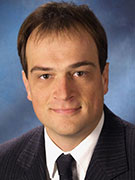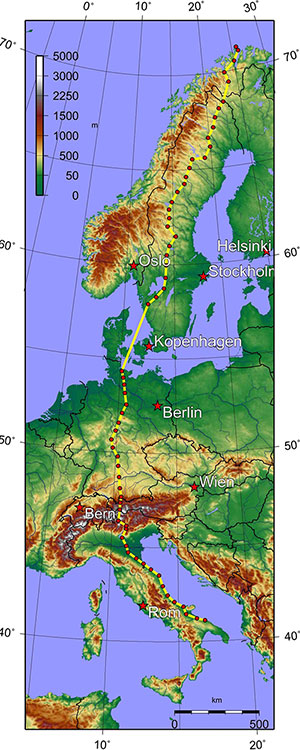01 Dec Ultra Long Distance Runners Regenerate Cartilage During Race

Dr. Schütz
MedicalResearch.com Interview with:
Uwe Schütz, M.D.
Radiologist and specialist in orthopedics and trauma surgery
Department of Diagnostic and Interventional Radiology
University Hospital of Ulm
Germany
Medical Research: What is the background for this study? What are the main findings?
Dr. Schütz: In this study, which is a small part of the Trans Europe Foot Race (TEFR) TEFR-project, we investigated the question, what happens to the joints, in detail to the joint cartilage of the lower extremities, when running 4500 km without any day rest for nearly 10 weeks. Is there really a risk for developing an arthrosis when doing this, like some researches and many physicians postulate?
Well, what we find when accompanying 44 ultra-athletes with a modern 1.5Tesla MRI mounted on a custom made 38tonnes truck trailer day by day over 64 days on their way throughout whole Europe is, that the joint cartilage is initially altered by this running burden: It shows signals of cartilage matrix degradation beneath the first 1000 to 1500 km of running. But then the situation changes. When further running occurs, then the cartilage shows the ability to partially regenerate under ongoing running burden. This is a pretty new and astonishing finding, first time measured and observed in human joint in vivo. But knowledge of Scandinavian animal studies show the same behavior in dog cartilage.
Medical Research: What should clinicians and patients take away from your report?
Dr. Schütz: So what we find is very interesting for every orthopedic surgeon, sports physician and the athlete itself: There seems to be no distance limit for running in the healthy cartilage regarding flat ground running. If you have healthy joint in the legs, no obesity, leg deformities or other injuries in the lower extremities, you just have to begin the running sport step by step, give yourself enough time to rise the distance, and there might be no limit regarding the risk of developing joint degeneration. The same statement we can give for other parts of the human body we investigated with this project: The brain, the muscles and normally the bones also. In the latter there is little exception: the risk of occurring a fatigue bone fracture when doing such an multistage ultra run is small but not to disclose. We had seen 2 in the 66 participants of the TEFR in 2009. And they all were well trained. But no subject showed any kind of new injuries or progress of focal low-grade cartilage lesions over all the way of 4500 km running.

Trans Europe Foot Race course map.
Medical Research: What recommendations do you have for future research as a result of this study?
Dr. Schütz: What we hope for future research is, that other colleagues pick up our results for new research protocols regarding our hypothesis, that cartilage develops a kind of equilibrium between degradation processes and regeneration processes when being involved in an ongoing running burden over more then the 4500 km. We think that there will be a plateau reached which will show such a steady state in normal flat ground running without distance limit. What we also have seen is that there is a leg difference between left and right MRI signal and therefore cartilage behavior as a respond to running forces even in highly trained ultra runners. We interprete this, that also these athletes have a leg preference like everyone of us, which could not be changed in total symmetrical running behavior. This is a future research question for sport medicines and neurophysiologists.
Last but not least, we opened the door for future research in the extreme poles of human performance with a new way of setting when taking high-end research machines like an MRI out of the laboratory directly to the object into reality. We hope that our success encourages other research colleagues for similar ideas. There is a risk of failure when doing this, but without this risk the may be no success.
Our results on brain research were we measured a mean loss of grey matter volume of 6.1% till the end of race is astonishing and also pretty new. Its difficult to say, what this means for brain function. As we showed total recovery after 3-6 months later it seems not to be harmful. But as we see brain volume changes in many neurological sicknesses, like chronic pain disorders, we hope that our findings will be a small but important information in future neuroradiological and neurophysiological research for better understanding in these entities and in the progress of different therapies.
Citation:
Radiological Society of North America. “Imaging identifies cartilage regeneration in long-distance runners.” Abstract Presented at the RSNA Meeting December 2015
Co-authors on the study are Christian Billich, M.D., Jutta Ellermann, M.D., Ph.D., Martin Ehrhardt, M.D., Daniel Schoss, M.D., Martin Brix, M.D., Siegfried Trattnig, M.D., Ph.D., Sabine Goed, M.D., Antje Reiner, M.D., and Meinrad J. Beer, M.D., Ph.D.
Uwe Schütz, M.D. (2015). Ultra Long Distance Runners Regenerate Cartilage During Race
Last Updated on December 1, 2015 by Marie Benz MD FAAD
